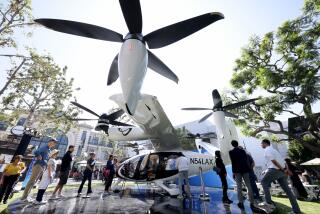San Franciscoâs hybrid taxis prove their worth
Reporting from San Francisco â Even here, in the capital of true believers in one thing or another, Paul Gillespie stands out.
The veteran cabby and former president of the San Francisco Taxicab Commission is one of the reasons this cityâs taxi fleet is vying to be the most environmentally correct in the country.
After years of advocating for hybrid taxis, Gillespie, who says he has âthe carbon footprint of an Ethiopian child,â now has proof that they are green in more ways than one.
San Franciscoâs first 15 hybrid taxis, all Ford Escapes, have made it to about the 300,000-mile mark -- nearing the cityâs official taxi retirement age -- and are being taken off the road. Their longevity shows that hybrid technology is more durable than previously imagined; they also have saved cab drivers about $9,000 a year, depending on gas prices and the number of shifts driven.
âFord never really intended this vehicle to be used as a taxi,â Gillespie said, as he tooled around the cityâs hilly Pacific Heights neighborhood in the silent hybrid. âWe adopted it because I was desperate to find a vehicle that would save drivers fuel costs and save greenhouse gas emissions.â
The hybrid Escapes were introduced with fanfare at a City Hall news conference in February 2005, touted by Mayor Gavin Newsom as the nationâs first fleet of hybrid taxis. Ten were owned by San Francisco Yellow Cab and five by Luxor Cab.
Today, 14% of San Franciscoâs 1,438 taxis are hybrids. Fifteen percent of New Yorkâs 13,237 cabs are, according to a spokesman for the cityâs Taxi and Limousine Commission, which just passed a hybrid incentive plan. Just more than 1% of Chicago cabs use hybrid technology, which increases gas mileage and lowers harmful emissions by generally harnessing an electric engine at low speeds and a gas engine at high speeds.
The city of Los Angeles is considering including such vehicles in its 2,300-car fleet, said Bruce Gillman, spokesman for the city Department of Transportation, but there are none yet.
Yellow Cab is San Franciscoâs biggest taxi company and has more hybrid vehicles than any other, said Hal Mellegard, company general manager, including 75 Escapes -- a small SUV -- and 21 Nissan Altimas.
Some drivers are loathe to give up the sturdy, gas-guzzling Crown Victoria cabs, with their âpolice-taxi packageâ of heavy-duty transmission, suspension and brakes, and all-vinyl interior, he said. But with erratic gas prices and a deep recession, the hybrids are increasingly popular.
âA driver driving a Crown Victoria might get $50 worth of gas. A driver driving a Ford Escape got $23,â Mellegard said, when gas was $4.50 a gallon. âThe money went into the driverâs pocket.â
Mellegard said the company began buying hybrids in 2004 because âwe sort of knew it was the technology of the immediate future, and we like to be green.â Various subsidies help offset the vehiclesâ cost.
In 2007, the city taxi commission required companies to reduce greenhouse gas emissions by 20% below 1990 levels. They must accomplish that by 2012, with twice as many cabs on the road.
The Ford Escape is the first American hybrid. When it was unveiled five years ago, customers feared that the batteries wouldnât last and would be expensive to replace, said Gil Portalatin, hybrid systems application manager at Ford Motor Co.
San Franciscoâs experience, he said, showed that âthese things are tougher than nails. . . . We warranty the batteries for 150,000 miles and here you have cabs going out of service at 300,000 -- because thatâs the law, not because the cabâs used up.â
The retiring hybrid cabs also have shown that, even on San Franciscoâs notorious hills, the regenerative brake systemâs brake pads last far longer than nonhybrid brakes.
With a regenerative braking system, brake pads are not used to slow the car in stop-and-go traffic. Instead, when the brake pedal is depressed, it sends a signal to the electric motor, which slows the vehicle and also charges the carâs high-voltage battery. The brake pads are used only at the very end of the stopping cycle.
Yellow Cab is awaiting the arrival of 10 new Ford Fusion sedans, which promise even better gas mileage than the Escapes. The company has had the Nissans only a couple of months, so itâs still evaluating their performance.
âWeâre still looking for the perfect cab,â Mellegard said. âThereâs new technology all the time. They may make something next year that runs on dirt and has zero emissions. Thatâs what Iâm hoping for.â
More to Read
Sign up for Essential California
The most important California stories and recommendations in your inbox every morning.
You may occasionally receive promotional content from the Los Angeles Times.











